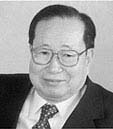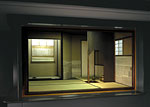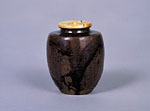|
|
|
|
|
||||||||||
HOME > the spirit of the brabd nihonbashi-bijin > Aesthetics of Iki–Natives of Edo
Intelligence naturally generated from beneath the surface of women and the dignity produced by intelligence develops in Nihonbashi-bijin, Japan Beauty from Edo-Tokyo, who is beautiful in body and mind. And as such, the Nihonbashi-bijin brand was born from the wisdom passed down from the Edo period. So we asked Mr. Tsunehiko Yoshi-i, the general manager of Mitsui Bunko, the largest business archives in Japan, for an explanation of the authentic traditions passed down to Nihonbashi.
The Jo'an tea house and tea ceremony utensils

Mr. Tsunehiko Yoshi-i
Executive Director and General Manager of Mitsui Bunko

Tea room exhibition space
Executive Director and General Manager of Mitsui Bunko

Tea room exhibition space
The Mitsui Family – Saviors of the national treasure, Jo'an
There is a reproduction of the interior of the Jo'an teahouse on display in the Mitsui Memorial Museum.
One of the most valuable legacies of the history of tea-ceremony culture is the teahouse called Jo'an. It was built at Kenninji Temple in Higashiyama, Kyoto in 1618 by the famous tea master, Oda Urakusai, younger brother of the warlord Oda Nobunaga. Jo'an features such refined architectural elements as the urakumado (type of window) and koyomibari (decorative wall coverings). Jo'an has since been moved to Inuyama City in Aichi Prefecture.
It is little known that the Mitsui family was responsible for preserving Jo'an. Takamine Mitsui, head of the Mitsui family from the Meiji to the Showa era, purchased Jo'an and moved it to the Mitsui residence in Imaicho, Azabu, Tokyo in 1908. Shortly after Jo'an was designated a national treasure in 1936, Takamine moved Jo'an to his villa in Ooiso in Kanagawa prefecture to protect it during the war. The Mitsui residence in Tokyo was destroyed in air raids during the war, but it was thanks to Takamine's keen foresight that the national treasure Jo'an was saved.
Not many people are aware of the fact that Takamine Mitsui contributed significantly to preserving not only Jo'an, but many other cultural assets as well. In commemoration of this, Jo'an is being reproduced at the Mitsui Memorial Museum under the supervision of teahouse researcher Toshinori Nakamura.
There is a reproduction of the interior of the Jo'an teahouse on display in the Mitsui Memorial Museum.
One of the most valuable legacies of the history of tea-ceremony culture is the teahouse called Jo'an. It was built at Kenninji Temple in Higashiyama, Kyoto in 1618 by the famous tea master, Oda Urakusai, younger brother of the warlord Oda Nobunaga. Jo'an features such refined architectural elements as the urakumado (type of window) and koyomibari (decorative wall coverings). Jo'an has since been moved to Inuyama City in Aichi Prefecture.
It is little known that the Mitsui family was responsible for preserving Jo'an. Takamine Mitsui, head of the Mitsui family from the Meiji to the Showa era, purchased Jo'an and moved it to the Mitsui residence in Imaicho, Azabu, Tokyo in 1908. Shortly after Jo'an was designated a national treasure in 1936, Takamine moved Jo'an to his villa in Ooiso in Kanagawa prefecture to protect it during the war. The Mitsui residence in Tokyo was destroyed in air raids during the war, but it was thanks to Takamine's keen foresight that the national treasure Jo'an was saved.
Not many people are aware of the fact that Takamine Mitsui contributed significantly to preserving not only Jo'an, but many other cultural assets as well. In commemoration of this, Jo'an is being reproduced at the Mitsui Memorial Museum under the supervision of teahouse researcher Toshinori Nakamura.

Kitano Katasuki tea caddy (O-meibutsu karamono katatsuki type; Important Cultural Asset)
Kitano Katatsuki
Of the many tea utensils passed down through the Mitsui family, the Kitano Katasuki tea caddy (O-meibutsu karamono katatsuki type) is a particularly fine example and an important cultural asset. It was a part of the Higashiyama Gyobutsu, a collection of objects once in the possession of Ashikaga shogunate family members such as Ashikaga Yoshimitsu and Yoshimasa. In 1587, it was exhibited in the Kitano Daichakai, the most famous tea ceremony event in history, and the warlord Toyotomi Hideyoshi is said to have taken special note of it.
The Mitsui family acquired the Kitano Katatsuki tea caddy in the mid-Edo era, and it is now a treasure of the Mitsui Memorial Museum collection.
Of the many tea utensils passed down through the Mitsui family, the Kitano Katasuki tea caddy (O-meibutsu karamono katatsuki type) is a particularly fine example and an important cultural asset. It was a part of the Higashiyama Gyobutsu, a collection of objects once in the possession of Ashikaga shogunate family members such as Ashikaga Yoshimitsu and Yoshimasa. In 1587, it was exhibited in the Kitano Daichakai, the most famous tea ceremony event in history, and the warlord Toyotomi Hideyoshi is said to have taken special note of it.
The Mitsui family acquired the Kitano Katatsuki tea caddy in the mid-Edo era, and it is now a treasure of the Mitsui Memorial Museum collection.

Tea basket (Karamono takegumi o-chakago type)
Photographs provided by Mitsui Bunko and the Mitsui Memorial Museum
Suki No Tamatebako (Treasure chest of elegance)
Tea box and tea basket
Tea boxes and baskets are small carriers for portable tea sets. Tea ceremony masters themselves select what to place in the sets, and using them is said to be the ultimate pastime of those adept in the tea ceremony. The Mitsui family was particularly fond of these boxes and baskets from the late Edo to the modern era.
The Mitsui Memorial Museum has approximately 30 examples of tea boxes and baskets that were donated by the Mitsui family. They were all created at the individual requests of Mitsui family heads or their spouses who personally searched for the tea bowls and vessels, holders for wiping-cloths, tea scoops, dishes for sweets, and other utensils that suited their tastes. They then wrapped the sets in sacks or large cloths to create a perfect personalized treasure chest of elegance.
The large tea basket favored by Takayoshi Mitsui, the 8th head of the Kita-Mitsui family, features a folded dyed cloth covering kettle mats and other cloth and paper items under which more than 40 other tea and incense utensils are neatly packed. Wealth and special collector routes are necessary for putting together such a superior set of small utensils, and it is truly one of the gems of the Mitsui family.
Visiting the Mitsui Memorial Museum and viewing all of these precious objects would be a perfect opportunity for the Nihonbashi-bijin to experience a world of affluence.
Tea box and tea basket
Tea boxes and baskets are small carriers for portable tea sets. Tea ceremony masters themselves select what to place in the sets, and using them is said to be the ultimate pastime of those adept in the tea ceremony. The Mitsui family was particularly fond of these boxes and baskets from the late Edo to the modern era.
The Mitsui Memorial Museum has approximately 30 examples of tea boxes and baskets that were donated by the Mitsui family. They were all created at the individual requests of Mitsui family heads or their spouses who personally searched for the tea bowls and vessels, holders for wiping-cloths, tea scoops, dishes for sweets, and other utensils that suited their tastes. They then wrapped the sets in sacks or large cloths to create a perfect personalized treasure chest of elegance.
The large tea basket favored by Takayoshi Mitsui, the 8th head of the Kita-Mitsui family, features a folded dyed cloth covering kettle mats and other cloth and paper items under which more than 40 other tea and incense utensils are neatly packed. Wealth and special collector routes are necessary for putting together such a superior set of small utensils, and it is truly one of the gems of the Mitsui family.
Visiting the Mitsui Memorial Museum and viewing all of these precious objects would be a perfect opportunity for the Nihonbashi-bijin to experience a world of affluence.
|



